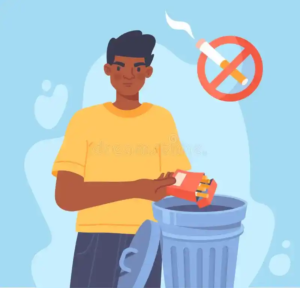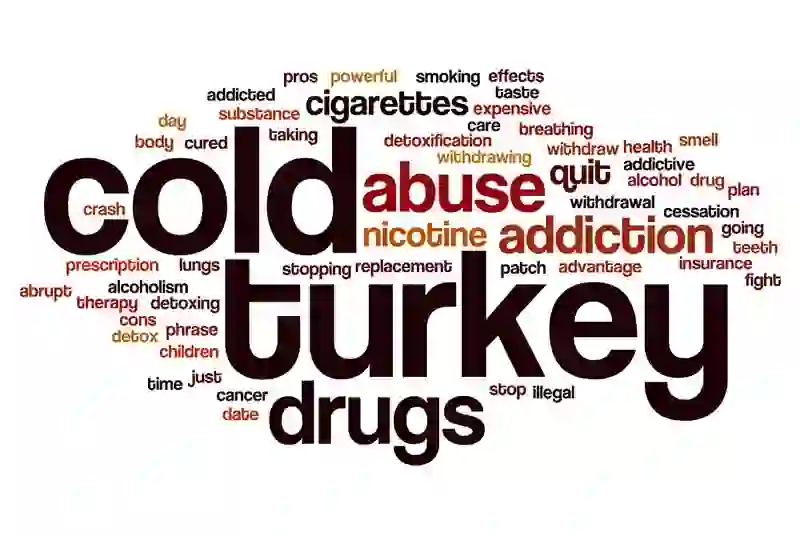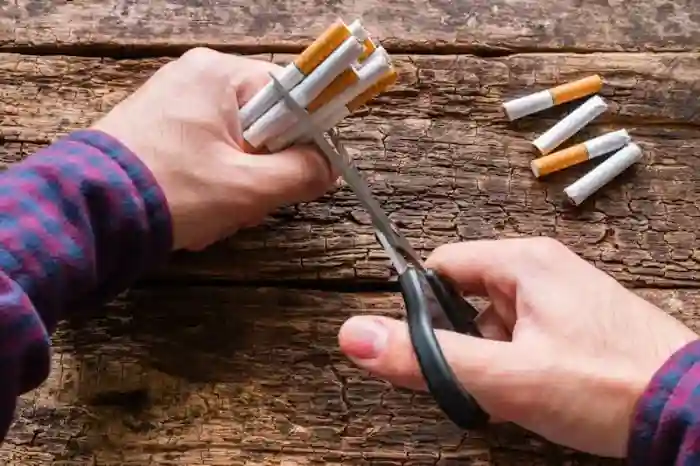
Quitting smoking is one of the most powerful decisions a person can make for their long-term health. Around the world and especially in the United States millions of people struggle with nicotine addiction, often trapped by tobacco products and deeply ingrained habits. While many options exist for quitting, such as nicotine replacement therapies (NRTs) and prescription medication, some people choose a more direct approach: quitting cold turkey.
The cold turkey method involves stopping smoking abruptly, without the use of nicotine replacement products or gradual reduction. For many, it represents an empowering step toward freedom from addiction, though it comes with its own set of challenges. This comprehensive guide explores the method in depth how it works, what to expect, and how to support your body and mind during the journey.
Understanding the Cold Turkey Method
Cold turkey is a term used to describe quitting an addictive substance suddenly, without tapering down or using alternatives. In the context of smoking cessation, it means putting out your last cigarette and deciding never to pick one up again no gum, no patches, no vaping, no nicotine sprays.
Although abrupt cessation might sound harsh, the cold turkey method is often praised for breaking the cycle of addiction completely. Unlike gradual weaning with nicotine replacement products, going cold turkey helps clear nicotine from the body in a shorter time, allowing the brain and body to reset without prolonged exposure to the addictive substance.
Why People Choose to Quit Smoking Cold Turkey

There are multiple reasons why many people choose the cold turkey method. Some want to eliminate nicotine from their systems right away without relying on nicotine products that could maintain the addiction cycle. Others are drawn to the sense of control and empowerment that cold turkey offers. For these individuals, it’s about making a strong, final decision: “I’m done.”
Another reason lies in the evidence. Studies have suggested that smokers who quit abruptly may have a higher success rate in the long run compared to those who quit gradually. This is particularly true when combined with a strong support system, emotional preparation, and behavioral tools.
The Role of Nicotine and Addiction
Nicotine is the central substance that drives cigarette addiction. Once inhaled, nicotine quickly enters the bloodstream and binds to receptors in the brain, releasing dopamine a chemical associated with pleasure, motivation, and reward.
However, with repeated exposure, the brain adapts, reducing its natural dopamine production and requiring more nicotine to achieve the same effects. Over time, this leads to psychological dependence and physical addiction. Smokers become conditioned to reach for a cigarette when they experience stress, boredom, or certain social triggers.
The addiction to nicotine is not just psychological; it’s biological. This is why withdrawal symptoms can be so intense and why people struggle to quit even when they desperately want to.
What to Expect: Withdrawal Symptoms
Quitting smoking cold turkey triggers immediate changes in the body. Nicotine levels start dropping within hours, and the detoxification process begins. Although this is the start of recovery, it also leads to withdrawal symptoms that can be challenging, especially in the first week.
Common nicotine withdrawal symptoms include:
- Irritability and mood swings
- Restlessness and difficulty concentrating
- Intense cravings for cigarettes
- Headaches and fatigue
- Insomnia or disrupted sleep
- Increased appetite
- Feelings of anxiety or sadness
These symptoms typically peak around days two to five and gradually begin to ease after the first week. However, psychological dependence can linger, especially for those who have used smoking as a coping mechanism for stress, loneliness, or emotional pain.
Health Benefits of Quitting Cold Turkey
While withdrawal symptoms can be difficult, the health benefits of quitting smoking are immediate and long-lasting. Within 20 minutes of your last cigarette, blood pressure and heart rate begin to normalize. Within 12 hours, carbon monoxide levels in your blood return to normal.
Over time, your body begins healing itself:
- After 2 weeks: Lung function improves, circulation increases
- After 3 months: Respiratory symptoms like coughing and wheezing decrease
- After 1 year: Risk of coronary heart disease drops by 50%
- After 5 years: Stroke risk drops to that of a nonsmoker
- After 10 years: Risk of lung cancer drops by half
Quitting smoking also helps prevent tooth decay, enhances your sense of taste and smell, and improves your skin tone. In the long run, it significantly reduces your risk of developing tobacco-related illnesses including lung cancer, heart disease, stroke, and chronic respiratory conditions.
Psychological Dependence and Emotional Preparation
Going cold turkey isn’t just about physical withdrawal it also requires mental resilience. Smoking is often linked to routines, emotions, and environmental triggers. People may smoke after meals, during breaks, or while driving. Breaking these associations takes time and strategy.
Emotional preparation is essential. Understanding that cravings are temporary and manageable allows people to stay focused on their goal. Techniques like mindfulness, journaling, breathing exercises, and visualization can reduce stress and help redirect impulses in healthier directions.
Developing a Solid Quit Plan
Even though cold turkey implies a sudden stop, having a quit plan increases your chances of long-term success. Preparation includes setting a quit date, understanding your triggers, and building a support system.
Choose a Quit Date
Pick a date that gives you enough time to mentally and physically prepare. Avoid dates when you’re likely to be stressed, such as a busy workweek or during travel. Mark the day and let your close friends or family know for added accountability.
Build Your Support System
Going through withdrawal alone is tough. Whether it's your family, friends, a support group, or an online community, having people who understand your journey can offer strength when you need it most.
Support systems whether from friends, family, a support group, or a healthcare provider—play a crucial role in quitting smoking cold turkey. Seeking help not only provides emotional backing but also improves abilities to manage withdrawal symptoms and intense cravings. You can also find structured, proven quitting strategies through your own book easy way to quit smoking, which offers a quit plan that many people have followed successfully. For medically reviewed, evidence-based advice and tips on how to prepare for triggers, handle cravings, and stay smoke‑free over time, the Smokefree.gov website offers an excellent, non-commercial blog-like resource that focuses on health improvement and quitting support.
Learn Your Triggers
Triggers vary from person to person. Some people smoke when they feel stressed, others during social gatherings. Identifying your triggers and planning alternatives—like chewing sugar-free gum, taking a walk, or sipping herbal tea—helps interrupt the habit loop.
Replace the Habit with Healthy Alternatives
Smoking takes up physical and mental space in your daily life. Fill that space with positive habits. Exercise, hydration, stretching, music, or hobbies can all become part of your new routine.
The Importance of a Support Group
Being part of a support group can significantly increase your chances of success. These groups—whether in person or online—provide encouragement, advice, and a place to share victories and setbacks. Simply hearing that others are going through similar experiences can offer reassurance and hope.
Family and friends also play a crucial role. The people closest to you can remind you why you quit, help distract you during cravings, and celebrate your milestones.
Alternative Methods: Therapy and Behavioral Treatment
 Cold turkey doesn’t exclude support from professional treatments. Many people benefit from cognitive behavioral therapy (CBT), which helps reshape negative thinking patterns associated with smoking.
Cold turkey doesn’t exclude support from professional treatments. Many people benefit from cognitive behavioral therapy (CBT), which helps reshape negative thinking patterns associated with smoking.
Therapists specializing in smoking cessation can help you identify the root causes of your addiction and build coping mechanisms. Other alternative methods like mindfulness meditation, acupuncture, and even hypnosis have shown potential in helping some individuals quit.
Understanding Nicotine Replacement Therapies (NRTs)
While cold turkey avoids NRTs, it's useful to understand them. NRTs include nicotine patches, gum, lozenges, inhalers, and nasal sprays. These products deliver small, controlled doses of nicotine to help manage withdrawal symptoms without the harmful chemicals found in cigarettes.
However, some people find that relying on these products prolongs the psychological attachment to nicotine. That’s why many cold turkey advocates choose to quit all nicotine use entirely and reset their bodies from the inside out.
Prescription Medications and Varenicline (Chantix)
Prescription medications like varenicline (brand name Chantix) and bupropion (Zyban) are designed to reduce nicotine cravings and ease withdrawal symptoms. These medications are not nicotine replacement therapies they work by affecting neurotransmitters in the brain to reduce the pleasure associated with smoking.
While effective for some, these medications must be used under the guidance of a doctor, especially for people with mental health conditions or substance abuse history.
Tobacco, E-Cigarettes, and Vaping Cessation
Quitting smoking doesn’t only mean quitting traditional cigarettes. Many people have turned to e-cigarettes or vaping products believing them to be safer. However, research has shown that e-cigarettes can still cause nicotine addiction and introduce harmful chemicals into the lungs.
If you're quitting vaping, many of the same cold turkey principles apply. Withdrawal symptoms, cravings, and psychological dependence are still challenges to address. Behavioral therapy, support systems, and health education remain key strategies.
Key Takeaways
- Cold turkey is a powerful method to quit smoking by stopping nicotine use entirely and immediately.
- Nicotine addiction involves both physical and psychological components.
- Withdrawal symptoms like irritability, cravings, and anxiety usually peak within a few days.
- Support systems, planning, and emotional preparation improve chances of success.
- Health benefits begin immediately after quitting and continue to grow over time.
- Therapy and support groups can enhance cold turkey success without using NRTs.
- Non-commercial informational resources like Smokefree.gov can provide additional guidance.
Final Thoughts: Your Journey to a Smoke-Free Life
Quitting smoking cold turkey may be one of the hardest things you ever do but it's also one of the most rewarding. The first few days are often the most challenging, but they also represent your body’s first step toward healing. With time, support, and commitment, you can break free from nicotine and reclaim control over your health, your habits, and your life.






